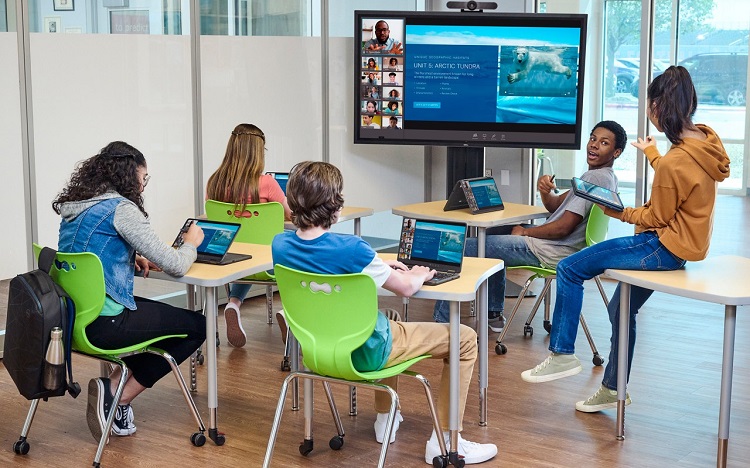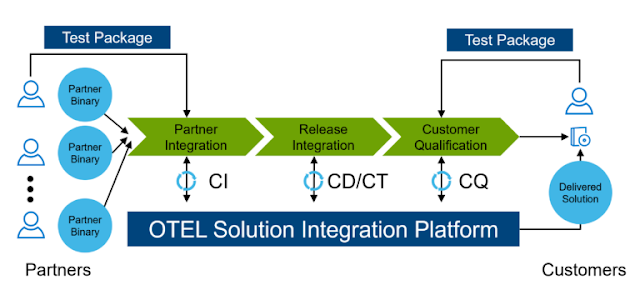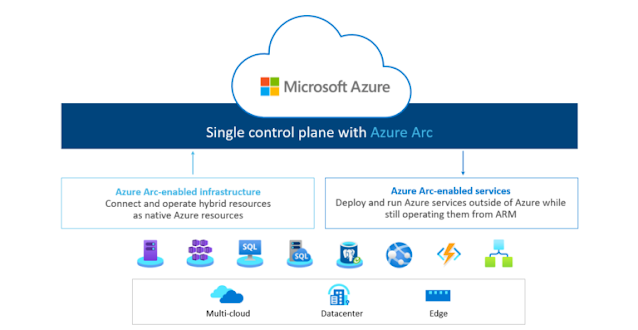Wednesday, 31 August 2022
Dell’s Storage Software-driven Innovation Continues with AppSync 4.5
Sunday, 28 August 2022
Technology Investments are Key to Customers’ Competitive Advantage
Thursday, 25 August 2022
Charting the Path Forward for a New School Year
In my 25 years as an elementary school teacher, supporting teacher professional learning and now leading the Education Strategy team at Dell Technologies, my favorite time of the year has always been ‘back to school’. It’s the prospect of a fresh start, a full year of chances to learn and new opportunities to impact learners.
Since the onset of the pandemic, we’ve worked hard to help our schools, students and teachers adjust to the unfamiliar realities of digital learning and remain connected in school districts from New York City to Albuquerque to Toronto and everywhere in between. This year, that work will continue, and it’s exciting. The opportunity to make an impact on young people’s lives through education is what keeps me engaged with school systems. As we prepare for the continued progression, let’s take a moment to reflect on what will ensure a successful year.
It might come as a shock to you, but Dell has been leading learner-centered professional learning for over 18 years and we have worked with thousands of school systems in North America. The need for this service will be even more important as the models of learning shift to more hybrid and blended. To that end, our education strategists and partners recognize first-hand how essential professional learning is as teachers continue to adjust to diverse learning environments.
That’s why we’ve continued to prioritize professional learning to equip our educators with the right tools and resources needed to transform teaching and learning. To meet this ongoing and pressing need, Dell has invested more than five million U.S. dollars over the last three years in professional learning for teachers– investments that ensured our students continued learning and will remain a priority in the years ahead.
In navigating the global technological shift, one thing has become clear: security and data privacy have emerged as significant challenges in the K-12 world. Our students’ and educators’ data and safety must be at the forefront of all of our conversations. Just this year, the Cybersecurity and Infrastructure Agency (CISA) released a new K-12 school security guide that helps schools create safe and secure learning environments without burdening teachers and administrators. Dell’s security solutions, including content filters, end-user management and cyberattack prevention/monitoring tools, build on that important work. It takes balancing access management and threat protection to ensure student and faculty safety and success.
Data privacy and security are important, but digital literacy will also be a defining skill and topic for the foreseeable future. As a technology company, we’re committed to driving towards the goal of all individuals and communities having the technical capacity needed to fully participate in society. That’s why we’ve partnered with ISTE to develop resources needed to advance digital literacy skills within communities.
Digital Skills for a Global Society provides resources to guide learners, educators and caregivers in getting the skills they need by taking a 30-minute customized questionnaire to evaluate their skills. After completing the questionnaire, resources are provided to guide their digital journey. Educators can dive deeper by registering for the Digital Literacy in the Classroom Course. The free five-hour online course will guide educators as they strengthen their digital literacy skills while also engaging in strategies for implementing digital literacy skills across the curriculum. These resources and many more are free to the education community to support this very important topic.
We remain committed to helping education systems as they transform teaching and learning. That is why Dell continues to invest in education strategists to support school systems in their transformation journey. For example, Berkeley County Schools, in West Virginia, collaborated with our Senior Education Strategist, Dr. Tara Nattrass, ensured that the district was preparing both its educators and students for the shift to a digital future. “Dr. Nattrass’ collaborative, unassuming approach allowed us to redefine ourselves through developing a new mission, vision and set of core beliefs. She educated, listened and internalized what was said by our team and guided us to a final, lasting product,” said Robyn Lopez, Director of Assessment and Accountability. As our education system continues to evolve, it’s our strong partnerships––similar to our relationship with Berkeley County Schools––that allow us to collectively meet education needs.
As our teachers and students return for another school year, we must build upon the progress we’ve made, lessons we have learned, and the emerging research to continue making new strides in improving the overall educational experience. We’ve begun to adapt and redefine the classroom and now it’s time to enable learning to happen anywhere, anytime.
Source: dell.com
Tuesday, 23 August 2022
Managing E-waste Responsibly: Critical Steps Towards a Circular Economy
E-waste not only poses health and environmental hazards, it’s also an untapped value that businesses of all sizes, across all sectors, could return to the circular economy.
According to the Global E-waste Monitor 2020, only 17.4 percent of e-waste is formally documented as being collected and recycled. The report estimates that globally, e-waste will reach 74 metric tons by 2030, nearly double the amount since 2014. According to UNESCAP, Asia generated the greatest volume of e-waste in 2019 — some 24.9 metric tons, followed by the Americas (13.1 mt) and Europe (12 mt), while Africa and Oceania generated 2.9 mt and 0.7 mt respectively.
The rapidly increasing rate is another concern for planning future e-waste management. The annual growth rate of e-waste was estimated to be 3-5%, which is about three times larger than other types of waste.
Good for Bottom Line, Better for Environment
The business case to protect our planet couldn’t be more evident. The global IT asset disposition market size was valued at 18.57 million USD in 2021. It is expected to increase to 51.38 million USD by 2030 at a CAGR of 12% during the forecast period of 2022–2030. The Asia Pacific market is projected to account for 25.44 USD million by 2030, expanding at a CAGR of 14%.
The same Global E-waste Monitor 2020 report also addresses financial implications. The report shows that the amount of iron, copper, gold and other minerals discarded in e-waste is valued at over 57 billion USD. Recovering those materials through proper recycling benefits the planet and businesses.
Start to Adopt Circular IT Strategies to Extend Product Life Cycles
Accelerating the circular economy is at the core of Dell Technologies Environmental, Social and Governance (ESG) goals. By moving away from the linear economy and embracing a circular one, we can design to reduce and reuse waste, and extend the useful life of products and materials to reduce environmental impact. At Dell, we believe technology will play a key role in this shift, and we see the circular economy as a critical business model for our collective future. As a global technology leader, we have a strong opportunity to minimize waste and as a result, emissions by driving circularity through everything we do.
When a product reaches its end of life, the materials can be reused and recycled, creating sustainable value within the circular economy. Supporting this model reduces environmental impact while giving businesses opportunities to increase competitiveness, stimulate innovation and revenue, reduce operating costs and create jobs.
We are also walking the talk. Since 1996, Dell has been offering secure recovery solutions for customers around the world. Since 2007, we have recovered more than 2.6 billion pounds (1.2 billion kilograms) of used electronics. Asset Recovery Services, for example, helps businesses securely and responsibly retire their IT equipment. Earlier this year, Dell expanded its support for Asset Recovery Services, which is now available in 36 countries.
Retire your IT Equipment Securely and Sustainably with Asset Recovery Services
When selecting a partner to help reduce your organization’s environmental impact and improve your sustainability practices, consider Dell’s Asset Recovery Services. By leveraging Dell’s long-standing security expertise and commitment to sustainability, you can responsibly resell, recycle or return to lease your legacy IT equipment and shift your focus to what’s next.
Here’s how it works:
◉ Return any brand. We’ll take back all of your owned or leased hardware, no matter where it came from.
◉ Leave the logistics to us. We’ll handle every detail from pick up to final reporting, so you can stay focused on your core business.
◉ Keep your data safe. We’ll sanitize devices in strict alignment with the NIST SP 800-88r1 standard to ensure data doesn’t fall into the wrong hands.
◉ Unlock value. Your aging asset may have more value than you think. Our goal is always to reuse, extending the life of the product as our first priority. We’ll resell your equipment and send the money back to you.
◉ Protect the planet. If your asset has no value, we’ll dispose of it in compliance with local regulatory guidelines.
◉ Peace of mind, on-demand. Customize and download status reports to keep track of your services from anywhere. Data sanitization, confirmation of disposal, and resell/recycle reports are at your fingertips.
Source: dell.com
Saturday, 20 August 2022
Why Dell IT Went All In on Workforce Personas
When it comes to providing tools and technology to today’s increasingly hybrid workforce, one size doesn’t fit all. And what does fit the needs of your team members today, may not fit tomorrow.
It is a realization that inspired Dell IT’s Team Member Experience organization (TMX) to transform the way we serve our 130,000 team members across Dell Technologies, from the workforce personas we use to define their needs to the way we leverage data to respond when those needs change—as they have dramatically in the past few years.
Of course, knowing your workforce is the key to delivering the ultimate team member experience. And since personas are the cornerstone of knowing your workforce, we started our transformation by honing this critical design tool.
Keeping Workforce Personas Evergreen
A persona is a fictional character that IT creates based on research to represent the different types of users of IT services and products.
After years of team member surveys, focus groups and shadowing people in their jobs, Dell Digital, Dell’s IT organization, became proficient at using personas to determine the right set of tools and technologies to best meet team member needs in their roles. When COVID-19 prompted a sudden shift to a home-based workforce, we learned that business needs and workforce needs can change with the snap of a finger.
We have since returned to a flexible hybrid workforce where team members still work from home more often, but the office remains an essential environment. That means we need to ensure we provide the tools that meet the way people work, wherever they are.
We needed a better way to let TMX personas keep pace with changing demands and priorities. We leveraged a comprehensive study by Dell’s Client Solutions Group (CSG) and insights from Dell Services to tap into hybrid workforce trends and redefine our personas. We then invested in telemetry tools to create a proactive support model that would correlate systems and satisfaction data to keep our persona practice evergreen and relevant going forward.
The result is a modern set of tools and processes, for not only equipping team members with the right devices, but also monitoring their experiences to identify and correct any challenges that arise. TMX is now able to recognize emerging trends for each worker persona and be more proactive and agile in addressing business teams’ needs.
A little more than a year into this transformation, we have garnered some of the highest team member satisfaction scores for technology services and products that we have ever achieved in the five years that TMX began measuring CSAT. The overall CSAT score climbed from 50 to 80 percent after deploying the new solution. We expect to see even greater team member satisfaction as we continue to deploy persona-driven technology through its normal life cycle processes.
Our TMX Evolution
Keeping Pace with Today’s Changes
Monday, 15 August 2022
APEX: Delivering Customer Choice and Partner Opportunity
Customers want outcome-based solutions, with a cloud-like simplified experience, while maintaining both flexibility and control. With Dell Technologies APEX, we deliver just that, with a growing set of offers, delivering modern consumption models and addressing the growing need of customers’ desire to purchase technology as a service.
Dell has always been about customer choice. Sometimes customers want to purchase products; but increasingly they want the benefits of an IT solution via a subscription to the product or service. The important thing is the outcome, and we know that one size does not fit all.
What started over two years ago, when APEX was announced, continues today with a steady drumbeat of “always on” enhancements and expansions. We’ve just extended our global availability of our APEX solutions to resell, which is expanding the opportunity for our partners around the world.
APEX offers more consumption choices for customers and more options for our partners to increase customer stickiness. It represents an amazing growth opportunity for our partners because it enables and empowers them to meet our customers’ increasing requests with choice and differentiation.
APEX enables partners to continue being responsive and agile to meet market demand. It also simplifies consumption, purchase and overall engagement with Dell, as well as an amazing opportunity to extend and enhance their own services.
Our entire partner ecosystem is key to our mutual success. Our APEX solutions offer them increased flexibility, agility and positions them to address the rapid growth opportunity of multicloud. The Partner ecosystem continues to assist customers with the increased complexity of navigating the current computing environment.
We continue working to enable the entire partner community to complement APEX solutions. Partners are incredibly well positioned with critical skills, capabilities and valuable industry and vertical expertise. Together, we are assisting customers to assess and determine the best place for specific workloads to be deployed, whether in public or private clouds, on-premise, or in a colocation data center.
APEX resell capability continues to expand for partners, as we march toward global expansion. It’s now available in the United States along with select countries in the EMEA and APJ regions. In addition, we continue adding new features to the console for an improved partner experience. Both custom and outcome-based offers, including APEX Flex on Demand, are available through the console.
The hallmarks of the APEX strategy for partners are continued momentum of enhancements and expansion, optimism for future growth and consistency in delivering on our promises.
Source: dell.com
Saturday, 13 August 2022
The OTEL Secret Sauce: Take a Sip
While I have always enjoyed cooking, one thing was always clear, my wife is a better cook than I am. She can take any recipe and make it better. Is there something extra or unique she does to amplify the recipe’s flavor? Maybe adding a little extra bouillon or seasoning salt and the right kind of tomato paste? Managing the optimal amount of garlic and mixing in each ingredient at the right time?
So, what does this have to do with Dell Technologies Open Telecom Ecosystem Lab (OTEL as we call it)? At MWC Barcelona this past year, we announced our OTEL Solution Integration Platform. The Solution Integration Platform is that “something extra” that makes OTEL unique. It uses the latest DevOps techniques to bring Communication Service Providers (CSPs) and partners in the telecom ecosystem together to conduct integration, testing, and ongoing lifecycle management of Open RAN, 5G, and edge services and applications.
Tuesday, 9 August 2022
Celebrating 25 Years of Precision Workstations Pushing the Boundaries
As we celebrate a quarter-century of Dell Precision innovations this year, we’ve unveiled some of the industry’s most powerful workstations. Since our first Precision workstation in 1997, Dell engineers have stepped up time and again, providing solutions for some of the most innovative minds in some of the most complex, ever-evolving professions. Driving many industry firsts, we introduced the world’s first mobile workstation in 2001 and the world’s first rackmount workstation in 2008.
Read More: DES-6332: Dell EMC VxRail Specialist Exam for Systems Administrator
One of this year’s firsts was featured in the launch of the Precision 7670 & 7770—the 7670 is the first 16” Precision mobile workstation and also the first to feature two chassis options, allowing professionals more options to scale according to their power needs. When our engineers identified impending transfer speed limitations in the current memory technology, SoDIMMs, we developed and presented an all-new Dell-patented innovation called CAMM (Compression Attached Memory Module). We are in discussions with the industry standards committee to help make CAMM a new standard, providing modularity and supporting repairability.
 |
| Dell Precision 7670 and 7770 mobile workstations. |
 |
| Dell Precision 5470 mobile workstation and Precision 7865 Tower workstation. |
Precision At Work: Now and to Come
 |
| VALACLAVA digital design. Image courtesy of Lui Iarocheski. |
“With digital twins, fabric and patterns can be manipulated in the virtual space to fit an avatar rather than on the body,” Iarocheski explained. “Cloth simulation is super demanding, and the Precision handles this task in a speedy manner without the software crashing. This power helped us to reduce our design process (for one digital garment) by 67%. It also gives me the portability that I need for visiting factories and meeting with the team, while the 17” screen means I can still share projects clearly without a separate monitor.”
What Other Experts are Saying
Celebrate With Us
Final Words
Monday, 8 August 2022
Predictive Maintenance: Reduce Downtime and Increase Profits
Over the past few years, companies have been focusing on leveraging their data to drive business insights. Internet of things (IoT) and sensors generate valuable information that can be used to reduce downtime and the costs associated with it. This can prove to be vital considering that 82% of companies have experienced at least one unplanned downtime incident over the past three years. Unplanned downtime costs as much as $50 billion a year to industrial manufacturers.
Companies aiming to reduce downtime have been implementing different maintenance strategies, which have been evolving through time. These can mostly be either reactive, preventive, or predictive.
Reactive maintenance occurs when a failure has already happened, unexpectedly, and it needs to be resolved. This usually means increased downtime and lost productivity.
Preventive maintenance refers to maintenance activities that are planned and executed at a regular interval. An example of this is a monthly maintenance of a machinery. This practice can potentially incur unnecessary costs, as perhaps there was no current or emerging issue that needed to be taken care of. It is done regardless because that’s the frequency that was estimated to be optimal.
Then the third type is called predictive maintenance. This refers to the maintenance in which companies leverage their past performance data and all the information that is generated by IoT or sensors. In predictive maintenance, machine learning – fueled by data-driven insights and real-time operating conditions monitoring and diagnosis – is used to optimize when and how to execute maintenance. Leveraging this type of predictive analysis can help avoid costly unnecessary repairs, while optimizing the utilization of the equipment and drastically reducing downtime.
Organizations identifying its value have started to shift from preventive to predictive maintenance. Predictive maintenance, based on IoT and sensor data, has the potential to transform business operations. Companies that understand and implement this technology will have a clear competitive advantage.
Dell Technologies realized significant cost savings from the use of a predictive maintenance application run in the Dell IT data lake, an agile storage platform that can be easily configured for any given data model, structure, application or query. This application leveraged data from sensors on connected devices, lab test results, and vendor technical specifications to determine the likelihood of a system drive failure based on factors ranging from usage to data center environmental conditions. Dell used this information to proactively replace drives that were predicted to fail in the near future. The company avoided more than $100 million in costs associated with repeatedly bringing technicians into its data centers for one-off fixes on failed drives.
To remain competitive and achieve higher margins, exploring how to implement predictive maintenance is likely the right call for most businesses. Learn how you can leverage your data to derive valuable business insights by visiting our Analytics Solutions page.
Source: dell.com
Saturday, 6 August 2022
Streamlining Azure Hybrid Cloud with Dell Azure Stack HCI
We are excited to bring the latest updates to the Dell Integrated System for Microsoft Azure Stack HCI. This May 2022 release is designed to streamline Azure hybrid cloud for our users by providing tools to deliver a seamless Azure experience across distributed locations while optimizing and simplifying Azure operations on-premises and accelerating innovation that fuel their business.
Delivering Seamless Azure Experience
Our latest release adds unique software-driven integrations with Azure that simplify operations across distributed locations, whether in the core datacenters or dispersed edge locations.
Through enhancements to Dell Open Manage Integration for Windows Admin Center, this release enables Azure Arc to serve as the centralized control plane for distributed on-premises Azure Stack HCI deployments. Customers can now monitor the health of the Azure Stack HCI infrastructure, perform operational tasks such as cluster creation and expansion, enforce consistent compliance policies across locations and remediate any drift from the defined policies in the event of non-compliance – all through the central Azure Arc control plane.
Optimizing Azure Infrastructure On-premises
Accelerating Innovation and Workload Execution
Friday, 5 August 2022
Bringing Self-Service Server Decommissioning to Dell IT
Server decommissioning is an essential part of the equipment lifecycle process for any organization—and Dell Technologies is no exception. Like many companies, we wanted to find a faster, smarter, more efficient way to do this.
That was the goal as our IT teams took on the challenge of managing the lifecycles of more than 120,000 servers in use across Dell Technologies, to ensure they are efficiently shut down when they need to be.
When the Dell Digital Server Decommissioning Product Team started this effort, Dell Digital, Dell’s IT organization, had a mix of decommissioning processes. We saw an opportunity to standardize processes and apply automation to increase efficiency and decrease decommissioning time.
Decommissioning a server means disconnecting it from the network and scrubbing all the data it contains. This requires involving a host of internal teams including storage, network, security and IT engineering, undertaking an array of manual steps.
If server decommissioning cleanup isn’t fully completed, it can lead to unused servers cluttering data centers and unnecessarily tying up resources such as power and IP addresses. There can also be instances where servers might get turned back on and become “orphan” servers, disassociated from their applications, but still occupying space in our environment.
After working with application owners, developers and multiple IT teams to analyze our server environment, the Server Decommissioning team created an automated, self-service process to improve this crucial task of properly decommissioning our servers. The team designed and implemented the Self-Service Decommissioning tool (SSD) that completes the server decommissioning process end-to-end in one tenth the time of previous manual processes.
In the first six months of the tool’s deployment, we’ve expedited our server decommissioning and saved millions of dollars in resource costs.
Here are some insights on our server decommissioning effort that might help your organization avoid server clutter in your IT environment.
Collaborating with Stakeholders to Hone the Process
The team began our decommissioning analysis by spending several quarters researching records, processes and collaborating with stakeholders to get a picture of our server environment and the existing process.
We found that it took an average of 64 days to perform the manual server decommissioning process spanning across various teams.
In the old days, server owners had to submit a request to get approval to decommission their devices within limited windows of time. Our Change Management Team would review requests weekly to ensure there were no moratoriums or production conflicts and then authorize owners to begin the server shutdown activities. Various factors could lead to requesters waiting weeks or even months before they could start the process.
Decommissioning was a very manual process and involved various teams to tackle the many tasks, such as reclaiming storage volume, removing backup data associated with the server, deleting associated virtual machines from our VM console, and more. Dell Digital Domain Name Service recycled valuable IP addresses which are always in limited supply.
Once we determined the existing process, the Server Decommissioning Team began working with IT, Change Management and the Dell Digital Zero Touch Engineering Teams to create an automated decommissioning process. Our ultimate goal was to make it easier and more efficient for teams to retire hardware from our environment.
We adopted a hybrid approach, where decommissioning requests would go through a newly created workflow that automatically checks for conflicts and authorizations. If it found no conflicts, the process then issues decommissioning approval. Our new automated decommission tool (ADT), developed by the Zero Touch Engineering Team, handles the actual decommissioning process, including self-service server shutdown, server status validation and the deletion of VMs.
Under the new process, once a request goes through the auto approval workflow, service shutdown is automatically triggered. Since there are no longer restricted windows of time for decommissioning, a server can now be shut down in as little as 24 hours.
The SSD tracks each request’s progress, keeping requesters informed on the status of their applications. The simplified, seamless and faster process has vastly improved SLAs for our team members and makes server owners a
Building a Self-service Path
ccountable for the fate of their devices.
By applying automation, we’ve decommissioned more servers, faster, and rectified the orphan servers matter. It has resulted in reclaiming 53K TB of disk and 364 TB of memory. This has led to millions of dollars in savings.
If your organization is looking to improve its server decommissioning process, my strongest advice is to not be afraid of dealing with the complexity of your existing environment. Do the analysis to determine your ecosystem’s current status. Work with stakeholders and your IT teams to resolve this nagging problem that otherwise will continue to grow.
Creating a self-service, automated server decommissioning process can free up team members to focus on what matters, gain cost savings through resource reclamation and, perhaps most importantly, help decrease cybersecurity vulnerabilities for your company.
Source: dell.com
Thursday, 4 August 2022
Why the Hybrid Workplace Needs a Hybrid IT Model
Hybrid work— people working seamlessly from both the office and a remote location— has been happening for years, but the COVID-19 pandemic accelerated the shift in ways few people anticipated. Ironically, while IT’s efforts to support these environments boosted business agility worker productivity, it also further complicated already complex IT portfolios.
Here’s the issue: This glut, comprising a hodge-podge of public cloud, private cloud and edge solutions from several vendors and homegrown on-premises tools, is proliferating as companies lean more heavily into their digital transformations. We call this phenomenon multicloud by default: portfolio sprawl that makes it difficult to be thoughtful and strategic with your multicloud approach.
Fortunately, a solution exists; embracing multicloud by design to form a more intentional approach to building and operating hybrid cloud systems. Before we delve more into this opportunity, it’s important to understand how we landed here.
Carried By the Cloud
People have been splitting time between their home and corporate work offices for years. What has changed is the number of people working remotely has vastly increased since the pandemic emerged the world over two years ago. And that has made IT systems more complicated.
Recall when in 2020 IT leaders tackled the unprecedented challenge of enabling thousands of employees to work from home. Some IT teams created new work personas to ensure that employees typically working from desktops in an office daily could work from home via laptops—overnight. Some companies even established customer service call centers in workers’ homes—ensuring their staff had the appropriate monitors, headsets and other necessary peripherals to serve customers—in days.
Cloud applications, led by video conferencing, team collaboration and virtual whiteboarding tools, made this shift possible. As corporations began allowing employees back into the offices, a cottage industry of pandemic-inspired digital experience applications sprang up to ease this transition to a hybrid workplace.
Cloud infrastructure largely fueled these tools, computing and storing data nimbly from the bottom of intricate software stacks. IT also built or subscribed to several connectors, or APIs, to ensure these tools communicated properly.
The Sprawl Struggle is Real
Most companies were already using Zoom, Teams and other collaboration and productivity tools to connect with colleagues. But as the pandemic deepened many organizations have found they’ve needed to add additional SaaS apps, including software that allows workers to reserve “hot desks,” COVID-19 screening apps and other tools to make office visits safer. In fact, many of those have become permanent solutions even as team members resume returning to corporate offices. And the new digital workforce tools continue to increase already dense IT portfolios to bloat.
Seventy-five percent of respondents surveyed by Enterprise Strategy Group in 2021 said that IT is more complex than it was just two years ago, with 38% identifying higher data volumes as a top driver of that increased complexity. The survey results also revealed 29% identifying increases in the number and types of applications as a driver.
And because many of these apps are connected to other apps running in public clouds or in other locations, their interdependencies grow—significantly, in some cases. All this incremental software adoption—again, much of it cloud-based—has yielded an even more unwieldy—and costly—IT portfolio. In many cases, these are challenges facing IT leaders on top of a full plate of digital transformation initiatives, and the need to reduce or eliminate technical debt.
Preparing for Future Trends
If it wasn’t enough for IT leaders to think about digital transformation and managing a broadening cloud portfolio, they also need to think about what’s to come. For example, leaders should expect greater IT challenges as companies began experimenting with context-aware computing, which relies on intelligent software and sensors. Context-aware computing provide workers real-time information at the right moment and in the appropriate location, often through a series of digital hand-offs, to employees working remotely or the office.
For example, we’re exploring concepts for seamless work experiences that let employees quickly log onto their computers, peripheral devices and applications simply by entering an intelligent workspace. In such an environment, a wireless dock could sense an employee’s PC, connect them to the network and adjust to their preferred display, while keeping the computer charged wirelessly throughout the day. No need to fuss with cables or cords.
Such computing can reduce friction and make it easier to transition from home to office, or vice-versa. Of course, while this new hybrid workplace is designed to deliver outcomes, it also portends greater complexity. It’s prudent for leaders to consider not just today’s IT requirements but what tomorrow’s environment may require.
You Need a More Agile Infrastructure
Regardless of what shape your context-aware computing profile takes, these outcomes are achieved through agile infrastructure that is also predicated on outcomes. This is best enabled via an as-a-service approach to infrastructure that affords IT leaders simplicity and control.
The idea is that your organization will realize the benefits afforded by the public cloud–elasticity and automation—but from the comfort of their own data center or a co-location facility. Ostensibly, you’ll have the cloud experience where you want it—private cloud, public cloud or edge.
Consider the context-aware computing case studies. As sensors and applications relay API calls to automatically control computers, monitors, camera and other connected, the digital hand-offs will occur seamlessly, thanks to the agile, as-a-service model.
What Will This Look Like?
You’ll rent, rather than buy, servers and storage in a self-service fashion, procuring them from a single, digital dashboard that puts the control at your fingertips, rather than entrusting someone else to make the decisions. You’ll pay for these services in a subscription model that will count as OPEX, helping you shed more of that CAPEX model you’ve already been fleeing as you embraced cloud services.
Consuming IT services via an on-demand model while retaining data on-premises to mitigate security, compliance, and performance concerns is attractive to many organizations. But don’t take our word for it. Try it out for yourself.
Source: dell.com
Wednesday, 3 August 2022
Revolutionizing Integrated Security: Modern Storage Experience
Digitalization has ushered in a data explosion in all organizations across all industries. Data volumes have continued to grow at a breakneck pace with no signs of abatement, thereby significantly altering the storage industry and its priorities. The disruption with cloud, cyber resiliency, application-driven economy and demands for transformation, are driving organizational strategy focused on management of storage solutions. IT leaders welcome this new world order as their organizations have benefited from improved business operations, personalized customer experience and agile innovation
But benefits often come hand-in-hand with challenges.
The increased reliance on data meant that organizations and their IT infrastructure are at greater risk from malicious attacks, human errors and negligent behaviors. Researcher ESG reported that 79% of companies globally had experienced a ransomware attack over the past year. Yet, according to our Global Data Protection Index Survey, 67% of IT decision-makers are not confident that their business-critical data can be recovered in the event of a cyberattack.
Furthermore, the permanence of digital transformation, accelerated by the pandemic, meant that data storage would require greater attention and investment; and cyber resiliency could no longer be an afterthought.
A Matter of When, Not If
In 2017, the WannaCry malware attack grabbed global headlines, and the man on the street quickly learned of a new word: ransomware. Today, threat of a cyberattack is real; unfortunately, no organization is immune to these bad actors. Cyberattacks are increasingly sophisticated, malicious and expensive. In a survey by Accenture, 81% of leaders think that staying ahead of attackers is a constant battle, and the cost is unsustainable. That is because the cost implications are even greater if we consider the negative impact on an organization’s reputation and stakeholder confidence. Here’s the bottom line: enterprise data is the golden goose, and protecting it is a business imperative. IT leaders need to think of storage as a part of a surround-sound security strategy.
Pivot to Software-defined Storage
Software-defined innovation paves the way for a continuously modern storage experience, as organizations try to find ways to manage the data explosion while keeping costs low. At this year’s Dell Technologies World conference, we announced a suite of upgrades to our storage portfolio that will enable our customers to win in the multicloud ecosystem. The benefits are incontestable: simplicity, cost savings and efficiency.
Take Dell’s VxRail as an example – we partnered with Cianbro Corporation to transform their storage capacity and bolster their disaster recovery capabilities. The result is simplified management and up to 80% cost savings compared to tape-based backup and recovery. Ultimately, software-defined storage enables organizations to efficiently and effectively manage data.
Air-gapped Cyber Vaults: What’s Not Connected Can’t Be Attacked
With the paradigm shift to a multicloud environment, we are seeing our customers move critical data away from the attack surface by logically isolating it from access within public clouds. This creates an “air gap” that provides an additional layer of defense by reducing the attack surface. This ensures that even when there is a sophisticated malware attack, organizations are still able to fulfill the three tenets of a purposeful recovery framework: isolation, immutability and intelligence.
Founders Federal Credit Union needed an air-gapped cyber security solution with AI, machine learning and automation that would integrate seamlessly with their IT environment. By deploying the PowerProtect Cyber Recovery solution, they could have 10 petabytes “mini-data center” protected in an isolated cyber vault and reduce the average server restore time from backups to 35 minutes while enabling automated cybersecurity reporting for IT audits.
Move from Cybersecurity to Cyber Resilience
The adage that prevention is better than cure is no longer relevant in today’s heightened threat landscape. In a cyber resilient mindset, the focus shifts from defense to mitigation. This ensures minimal disruption and loss. It is important to note that resiliency is not a technology but a strategy or, better yet, an outcome.
IDEC Corporation in Japan implemented the Dell EMC PowerMax 2000 to enhance its storage infrastructure reliability, availability and performance while supporting current applications and operating systems. Likewise, the University of Pisa leveraged the PowerMax for its mission-critical applications such as admin functions, teaching and labs, ensuring that these workloads run in a highly resilient and cost-efficient environment that will continue to operate, even in event of a breach.
Integrated security is a key pillar in the modern storage experience. Protecting data and infrastructure calls for a software-defined approach that leverages innovation for scale, agility and intelligence, aligns around outcomes rather than threats and is proactive in recovery planning.
Source: dell.com
Tuesday, 2 August 2022
Taking DevOps Productivity to New Heights with AIOps Automation
AIOps applications are a hot topic, and their ability to integrate with other tools in the IT management ecosystem has big implications about how to step-up daily operations productivity.
As Stephen Elliott from the IDC analyst group explains in the video below, AIOps is a new class of application that applies knowledge, based on machine learning and analytics, to provide insights and recommendations that improve and accelerate IT Operations. Leveraging automation, AIOps can further accelerate positive IT, DevOps and, ultimately, business outcomes.
CloudIQ is Dell’s AIOps proactive monitoring and predictive analytics application for Dell servers, storage, data protection and network systems. With hundreds of software engineers continuously churning out new CloudIQ features, we’re constantly soliciting feedback from the thousands of CloudIQ users.
AIOps Users Speak Out
User surveys show that CloudIQ’s AI/ML-driven capabilities result in 2X to 10X faster time-to-resolution of issues and saves IT specialists an average workday (nine hours) per week. CloudIQ user surveys also reveal how IT teams are thinking about ways to leverage AIOps insights with automation and increase gains. While nearly a third of users are undecided about how to leverage AIOps insights with automation, more than two-thirds want to use them to automate actions, but with various degrees of oversight and control.
CloudIQ Webhook and the CloudIQ REST API are new features that will address those needs by enabling your ITOps, DevOps and SRE (Site Reliability Engineering) teams to integrate data and insights from CloudIQ into your IT Monitoring and Orchestration application ecosystem. CloudIQ’s trusted data and insights become the intelligence that will drive IT automation to further reduce toil.





















